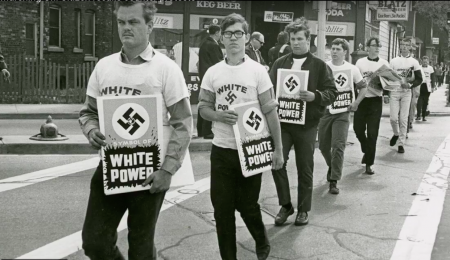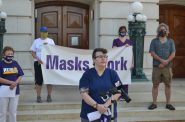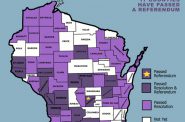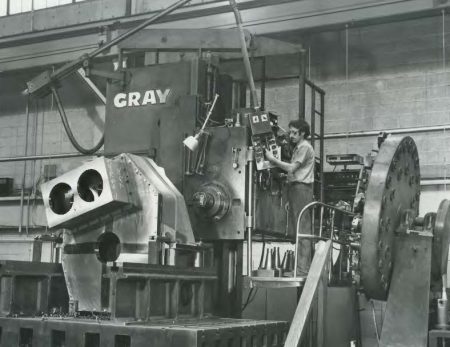White Power in Milwaukee
Open housing marches of 1967 triggered ugly reactions from whites.
Editor’s note: This article is republished with permission from “Marching On: 50 Years After the Milwaukee Marches,” a project of a journalism capstone class at Marquette University’s Diederich College of Communication.
Gus Ricca recalls 1967 as a frightening time for everyone in Milwaukee, not just for African-Americans who faced down white protesters as they marched for open housing.
Now 72, Ricca graduated from Hurley High School in 1963 and moved to Milwaukee in 1964 looking for a job, just a few years before the marches began. He was living on 24th Street and Kilbourn Avenue, near the Eagles Club, an all-white fraternal organization complete with workout areas and a dance hall. The club was a frequent counter-protest location and a haven for many racist bigots, Ricca said.
“I saw demonstrations take place at the Eagles Club and, to be quite frank, it was frightening,” said Ricca, a former factory worker at Falk Corp., 3001 W. Canal St.
“I didn’t join in on the counter-protests,” he added, “because I hadn’t really chosen a side in the issue. But looking back on it, sitting out of it was just as bad as being a part of the (counter) demonstrations.”
Many white residents felt as though they were trapped, Ricca said, because if they spoke up for African-Americans, they would be shunned in their communities.
“A lot of whites were worried about their house prices dropping with African-Americans making their way into the area,” he said. “African-Americans made their presence felt immediately and a lot of whites just weren’t connected with the issue.”
Ricca said many were also fearful because African-Americans were standing up to racism and whites were not ready for change.
“Malcolm X was a leader that I read about a lot, and I think he definitely put the fear of God into a lot of people,” he said of the civil rights leader, who was slain in New York in 1965. “You knew that he wasn’t going to back down, and neither were the African-American people; they had a real reason to fight.”
Ricca added that “whites were fearful that they would fall into the minority,” and that “people in general don’t like change, in my opinion, because it almost makes them feel like they can be at a disadvantage.”
At the time, Ricca’s friend Kenneth Germanson lived in an all-white area on the city’s South Side, just north of General Mitchell International Airport. Germanson, now 88, witnessed the resistance as a Milwaukee Sentinel reporter.
“I had neighbors who would chant racist slurs — and a favorite of theirs was, ‘E-I, E-I, E-I, O, Father Groppi’s got to go,’” Germanson said, referring to the famed white priest who helped lead the marches. “I was not involved in the marches at all, but there were times where I was a coward, and didn’t stand up for African-Americans being heckled by my racist neighbors.”
Germanson, who has lived in the Town of Lake for 53 years, remembers once arriving at his house and being greeted with a racist remark by a neighbor: “Welcome to our neighborhood – the last bastion of whites.”
In that moment, Germanson said, he took “the coward’s way out” and didn’t stand up to him. Today, he points out, there are signs around the community that say, “All people are welcome, regardless of where they came from.”

Nazis march along 16th St. at Forest Home on Sept. 23, 1967. Photo courtesy of Milwaukee Journal Sentinel and Milwaukee Public Library.
Even so, he believes that racism still exists in Milwaukee, mostly because “people don’t have the courage to stand up for each other.”
Ricca offered another reason why discrimination still exists.
“I know a lot of my friends’ parents were military families and they had different beliefs than others,” he said. “Racist sentiments have been passed down to families for years — and it’s just not right.”
Rocky Marcoux, commissioner of the Milwaukee Department of City Development, has lived in the city since graduating from Marquette University in the 1970s. He said he believes that race relations have significantly improved in the city, but there is still a long way to go.
“There was an open wound in the sense that the African-American community felt left out 50 years ago,” Marcoux said, “and today, most of the poverty that we have seen over the years is driven by that very racial divide.”
The commissioner added: “The racial issues are real in this city, and it’s evident in where the white population has gone since the housing marches. Many have fled to suburban areas in Milwaukee County and beyond.”
Germanson said “a majority of the whites” who lived on the South Side 50 years ago moved to the suburbs to “get away from it all.”
Whatever their reasons, Germanson said, “they were magnified by the hatred.” Looking back on it now, he added, “I don’t think anything justified the hatred that was shown.”
This story was originally published by Milwaukee Neighborhood News Service, where you can find other stories reporting on fifteen city neighborhoods in Milwaukee.
50 Years After The Marches
-
Pandemic Shines Spotlight on Workers’ Struggle
 Sep 7th, 2020 by Erik Gunn
Sep 7th, 2020 by Erik Gunn
-
UW System Expects $212 million in Losses
![Van Hise Hall in the background. Photo by James Steakley (Own work) [CC BY-SA 3.0 (https://creativecommons.org/licenses/by-sa/3.0) or GFDL (http://www.gnu.org/copyleft/fdl.html)], via Wikimedia Commons](https://urbanmilwaukee.com/wp-content/uploads/2017/10/1017px-Ingraham_Van_Hise_carillon-185x122.jpg) May 8th, 2020 by Rich Kremer
May 8th, 2020 by Rich Kremer
-
51 of 72 Counties Now Back Fair Maps
 Apr 15th, 2020 by Matt Rothschild
Apr 15th, 2020 by Matt Rothschild






















Germanson said “a majority of the whites” who lived on the South Side 50 years ago moved to the suburbs to “get away from it all.”
No mention of the forced busing plan enforced by MPS. What did we learn from that. We learned students didn’t like 45 minute bus rides across the city, we learned that their was no student improvement in education scores. We learned that both Black and White families did not like the program . We do know that if you owned a yellow bus company that you did pretty well financially.
Hey look Troll Jason there you are. Do you have a copy of that picture in your living room or had you not seen it in a while?
Fantastic article… love hearing this sort of living history from people that experienced it.
Great article! For those that imagine nobody liked the program, as a white kid in the early 1970’s bused from the ‘burbs to an inner-city school (despite the still memorable bus ride) the MPS busing program made me a better, more respectful person as an adult. I don’t know what impact the experience had on my grades, but it DEFINITELY had a positive impact on me as a human, and helped me understand my unearned white privilege at a very young age.
Racism is not a natural human behavior. It is learned.
Thank you Brian for posting relevant information that relates to the article.